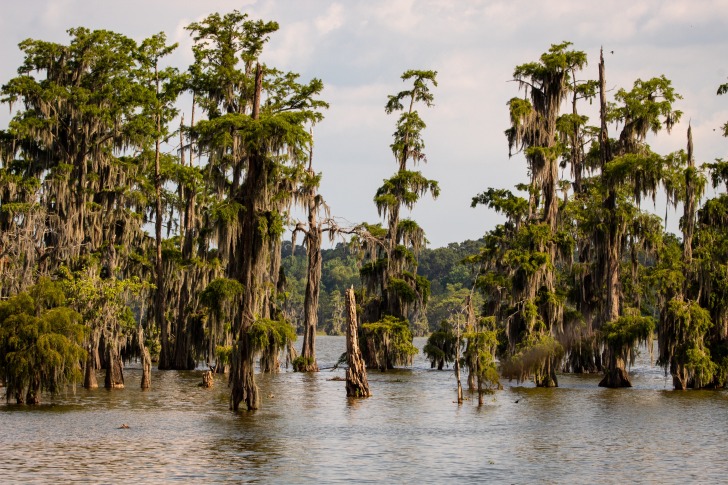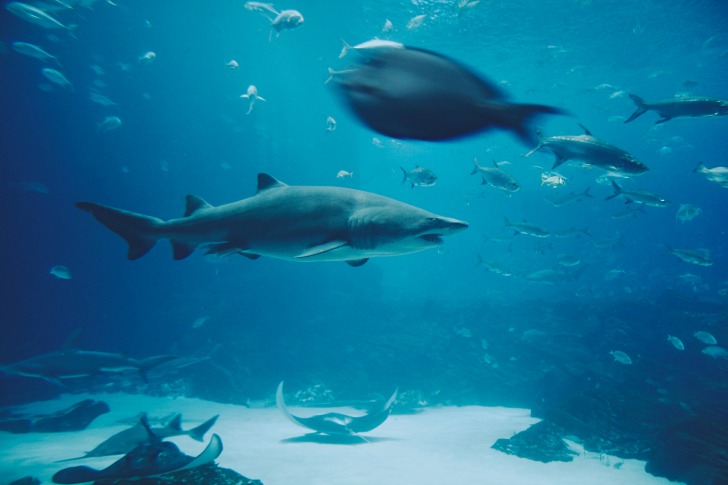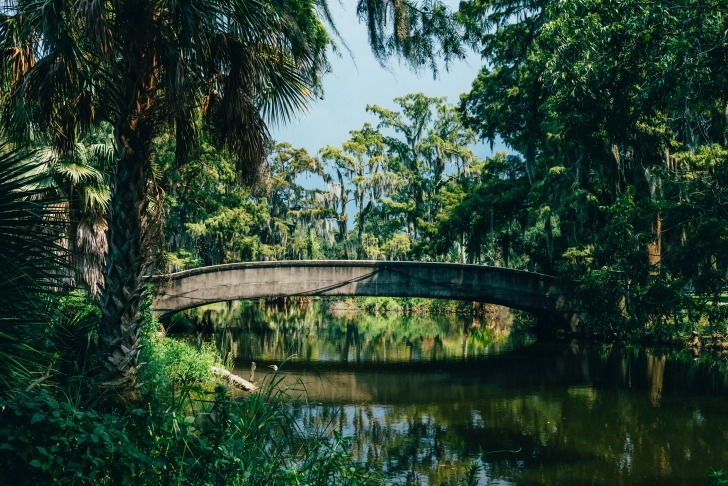This cracked me up:
“Louisiana is home to a lot of sharks, we’re talking fish here, not politicians, but we have some of those, too,” says Mexican Gulf Fishing Company.
I laughed so hard, seeing text versions of “HaHa!” and “LOL” in my head when I saw this quote.

Contents
So… Are There Sharks in Louisiana?
You’ll definitely see sharks in Louisiana in various places along the Gulf Coast and inland.
One of the hotspots is Lake Pontchartrain, which borders New Orleans to the north and west.
You’ll most likely also see sharks in Lake Borgne and Lake Maurepas.
They swim this route from the Gulf of Mexico.
According to the Mexican Gulf Fishing Company, one reason for so many sharks is that mothers nurse their young in Louisiana’s bays and lakes.
Then, they grow up to an adolescent age.
The prime baby shark nursery area lies near the Calcasieu Parish between Louisiana and Jefferson Counties.
Hundreds of female sharks reside in this area with their young.
Other evidence reveals shark nursing activity in the northern part of the Gulf of Mexico.
Bull sharks
Bull sharks can live in both freshwater and saltwater.
They’re called “one of the most aggressive and unpredictable types of sharks” as described by Channel 15 in Indiana.
That remark about bull sharks came from a story reported by Kenny Lopez and Joceline Joiner in August 2022.
They interviewed fisherman Joseph Rohaley, who caught a bull shark that measured 5 feet, 5 inches long.
More than 5 feet long is not the most they can grow, however.
Some bull sharks have reached at least 7-11 feet (2.1-3.3 meters) in length.
The adults can weigh 200-500 pounds, as reported by the National Wildlife Federation (NWF).
Bull sharks can live in both saltwater and freshwater.
That explains why you’d see them in Louisiana’s lakes, bays, canals, and more.
You’ll recognize a bull shark by its stubby, blunt nose.
Blacktips
The blacktip shark has a sleek and streamlined shape, according to Louisiana Sportsman’s Jerald Horst.
In 2011, Horst said that “the Gulf of Mexico is home to a lot of sharks” but mentioned the blacktip as one of the most common inshore types, along with the bull shark.
You might also spot bull sharks in the Mississippi River near St. Francisville, LA.
Blacktip sharks reach a maximum of about eight feet long, which isn’t the biggest.
However, it’s large enough.
When you think about how humans only grow to an average height of about 5 feet 9 inches, eight feet are still giant.
Blacktips don’t weigh the most that this type of creature can weigh, but it does put on anywhere from 60-220 pounds.
Spinners
I know not everyone condones shark fishing, but I did use an interactive map used by fishers to see where spinner sharks might reside near Louisiana.
You may see them south of Saint Louis Bay, Mississippi, and Gulfport, Mississippi near Cat Island, northwest of New Orleans near Lake Borgne.
If you could travel by boat or car from Cat Island to New Orleans, it would be about one or two hours.
That’s how close the spinner sharks in MS are to Louisiana.
Spinner sharks grow to an average of 5-6 feet and can weigh as much as 200 pounds.
They often live as many as 20 years.
Hammerheads
I know how many miles sharks can swim, which is about 50 miles a day.
What’s more, hammerheads can swim about 25 miles per hour if they want to.
That’s why I say that hammerheads from the Gulf of Mexico near Orange Beach, Alabama could easily end up in Louisiana.
If they swim from Orange Beach to New Orleans, they might get there in about two days.
It’s only about 131 nautical miles (miles by water) between Orange Beach and New Orleans.
That’s why.
Is it Safe to Swim in Louisiana?
Apparently, it’s more likely to be struck by lightning than to suffer a shark attack, so that may not be your top concern when swimming in Louisiana.
Sharks also usually don’t attack people unprovoked.
However, it does occasionally happen.
For instance, a 7-year-old got bit in Lake Pontchartrain, according to NBC Staff Writer Tanya Lewis.
Local authorities and lifeguards will let you know if you should enter Louisiana waters or not.
It’s usually safe to swim in this state, but pay attention to warnings.
If you hear of sharks in the water, don’t swim there.
Beware of pollution in beach waters and hurricanes too.
You’re more likely to deal with water contamination and tropical storms before you encounter a shark when swimming.
Places you Can Swim
Places you can swim include the Chitto River.
You also can enjoy tubing in this river, unless you’ve been told otherwise when you arrive there.
You will also find spots to swim when you visit the Kisatchie Bayou Campground.
Toledo Bend, which is the fifth largest lake in the United States, has room for you in its waters as well, and fishing is allowed here.
Lake End Park in Morgan City also welcomes swimmers.
Here you can swim and take time to appreciate the ancient oaks present here and take a few pictures to remember the moment.
Silver Creek in Mount Hermon, Tchefuncte River, and Indian Creek Recreational Area in Woodworth are some more swimming spots.
Other water activities, such as boating or fishing, also occur in some of these spots.

Interesting Shark Facts in Louisiana
Back in 2009, the Louisiana Department of Wildlife and Fisheries told Channel 9 news about sharks in the Atchafalaya Basin Swamp.
“Most people have a preconceived notion that sharks are found in the ocean,” reported Jim Shannon.
Mike Walker of Wildlife Fisheries confirmed the presence of sharks in the Atchafalaya freshwaters, which also proves that they don’t always need to live in the ocean.
Researchers also have spotted sharks traveling 900 miles up the Mississippi River.
Trappers caught some of them in St. Louis.
That’s not necessarily the longest they’ve trekked though.
Sharks have often put on thousands of miles.
Attacks Increase During Full Moons
Both the Louisiana State University and the University of Florida found reason to believe that shark attacks occur more during full lunar phases.
Researchers don’t know exactly why yet, as reported in 2022.
However, they took into account the periods when shark attacks occurred between 1960-2015.
I sometimes read reports like this and roll my eyes.
When I checked out sources for this, I wondered if they were trying to manipulate data for a tourism industry advertiser.
There could be truth to this, however.
I don’t know much about the connection between the moon phases and how it affects the seas.
However, I have heard about how the strong gravitational pull during full moon phases can affect the moods of humans and water tides.
It’s not totally inconceivable that it could affect sea or freshwater animal activity too, I suppose.
“So, although it seems unlikely that you will ever encounter a shark in a freshwater lake, you might want to keep an eye out next time you’re on a river,” said Oceana in 2012.
Even some of Louisiana’s sharks can also handle saltwater, especially the bull shark.
So why would you find it in rivers and lakes?
The Bull Shark is one that can handle freshwater the most, so you’ll see it in Louisiana more often than other sharks.
In fact, it seems that’s all the state talks about when reporting stories about shark sightings – almost.
Occasionally, hammerheads, blacktips, and spinners show up in Louisiana.
Why would they be there?
I did find out that more than 40 species of sharks can swim through freshwater looking for food.
However, they won’t stay there long because they can’t survive there.
3 Safety Tips for Swimming in Shark-infested Waters
1. Teach children not to “tease” sharks.
I highly doubt a child, such as the seven-year-old bit by a full shark in Louisiana, would know how to intentionally aggravate a dangerous animal.
A child may not always understand what a shark is capable of, however.
Young people might tease or make fun of a shark, not realizing the consequences that could occur.
This may provoke a shark even if a child doesn’t mean any harm, causing a bite to occur.
2. Swim only in daylight.
This will avoid the chance that a shark may mistake you for prey.
It will also avoid you from becoming attacked because of the shark’s poor vision.
Also, don’t enter the waters at dawn or dusk when sharks eat the most.
3. Don’t ignore “no swimming” signs.
This may seem elementary to some people, but it’s worth mentioning again.
When you disobey “no swimming” rules, it can have consequences.
One of those consequences could be a shark attack.
Otherwise, a high tide could sweep you away without you expecting it.
The water may also have too high of a pollution reading, so you can’t safely swim there.
Just don’t if the sign says not to.
Summary
Sharks do exist in Louisiana.
The bull shark seems to dominate this area’s freshwater the most.
However, you will occasionally find other saltwater sharks show up here looking for food.
Louisiana Safety Overview
READ THE FULL REPORT: Louisiana Safety Review
Safety Index:
- OVERALL RISK: MEDIUM
- TRANSPORT & TAXIS RISK: LOW
- PICKPOCKETS RISK: MEDIUM
- NATURAL DISASTERS RISK: HIGH
- MUGGING RISK: MEDIUM
- TERRORISM RISK: LOW
- SCAMS RISK: MEDIUM
- WOMEN TRAVELERS RISK: HIGH
Frequently Asked Questions
How many people in Louisiana die from shark attacks?
Louisiana had only one non-fatal shark attack since 1914, as updated in 2020.
Only six non-fatal attacks have occurred since then too, also unprovoked.
Three other provoked shark attacks have also taken place since the early 1900s.
The total bite average reported in 2020 is almost zero bites per year.
Does Louisiana have bacteria in its water?
It may have bacteria in some locations.
Watch out for reports about enterococci bacteria, which sometimes cause infections and rashes.
You have to be especially careful near beach locations, but they’re usually monitored by local municipalities who will let you know when it’s safe to enter the waters.
How do I know if I can swim in Louisiana waters?
At some of the popular beaches, such as Constance, Cypremort, or Elmer’s Island, you can view an updated beach report.
Look for these updates posted on the Louisiana Department of Health website.












Sharks do exist in Louisiana, with the bull shark being the most dominant species in freshwater and occasional sightings of other saltwater sharks looking for food.